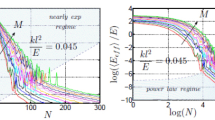Abstract
We consider a constitutive model for polycrystalline ice, which contains delayed-elastic and viscous deformations, and a damage variable. The damage variable is coupled to the delayed-elastic deformation by a fiber bundle ansatz. We construct an isotropic theory, which can be calibrated with experimental data. Furthermore, we generalize the theory to a damage model in terms of rank-four tensors. This general model allows the evolution of anisotropic damage.
Similar content being viewed by others
References
Chaboche J.L.: Thermodynamically founded CDM models for creep and other conditions. In: Altenbach, H., Skrzypek, J.J. (eds.) Creep and Damage in Materials and Structures, chap. 5., pp. 209–283. Springer, Wien, NY (1999)
Corless R., Gonnet G., Hare D., Jeffrey D., Knuth D.: On the Lambert W-function. Adv. Comput. Math. 5(1), 329–359 (1996)
Duddu R., Waisman H.: A temperature dependent creep damage model for polycrystalline ice. Mech. Mater. 46, 23–41 (2012)
Greve R.: Kontinuumsmechanik. Springer, Berlin (2003)
Hutter K., Jöhnk K.: Continuum Methods of Physical Modeling: Continuum Mechanics, Dimensional Analysis, Turbulence. Springer, Berlin, Germany (2004)
Jacka T.H.: The time and strain required for development of minimum strain rates in ice. Cold Regions Sci. Technol. 8(3), 261–268 (1984)
Kachanov, L.M.: Time of the rupture process under creep conditions (in Russian). Izv. Akad. Nauk. USSR, Otd. Tekh. Nauk., pp. 26–31 (1957)
Keller, A., Hutter, K.: On the thermodynamic consistency of the equivalence principle in continuum damage mechanics. J. Mech. Phys. Solids 59(5), 1115–1120 (2011). doi:10.1016/j.jmps.2011.01.015 . http://www.sciencedirect.com/science/article/B6TXB-523CDY6-2/2/bda2f1b70e114f23d673d5cbff6f7e1d
Keller, A., Hutter, K.: A viscoelastic damage model for polycrystalline ice, inspired by Weibull-distributed fiber bundle models. Part II: Thermodynamics of a rank-4 damage model. Continuum Mech. Thermodyn. doi:10.1007/s00161-014-0335-z
Krajcinovic D.: Damage Mechanics. North-Holland, Amsterdam (1996)
Kun F., Moreno Y., Hidalgo R., Herrmann H.: Creep rupture has two universality classes. EPL (Europhys. Lett.) 63, 347 (2003)
Lemaitre J., Lippmann H.: A Course on Damage Mechanics, vol. 2. Springer, Berlin (1996)
Mahrenholtz, O., Wu, Z.: Determination of creep damage parameters for polycrystalline ice. Advances in Ice Technology (3rd Int. Conf. Ice Tech./Cambridge USA) pp. 181–192 (1992)
Nemat-Nasser S., Hori M.: Micromechanics: Overall Properties of Heterogeneous Materials, vol. 37. North-Holland, Amsterdam (1993)
Pralong A., Hutter K., Funk M.: Anisotropic damage mechanics for viscoelastic ice. Contin. Mech. Thermodyn. 17(5), 387–408 (2006). doi:10.1007/s00161-005-0002-5
Rist M., Murrell S.: Relationship between creep and fracture of ice. Mech. Creep-brittle Mater. 2, 355–369 (1991)
Schulson E., Duval P.: Creep and Fracture of Ice. Cambridge University Press, Cambridge (2009)
Sinha N.K.: Crack-enhanced creep in polycrystalline material: strain-rate sensitive strength and deformation of ice. J. Mater. Sci. 23(12), 4415–4428 (1988)
Skrzypek J.J., Ganczarski A.: Modeling of Material Damage and Failure of Structures. Springer, Berlin (1999)
Szyszkowski W., Glockner P.: On a multiaxial constitutive law for ice. Mech. Mater. 5(1), 49–71 (1986)
Weiss J., Gay M.: Fracturing of ice under compression creep as revealed by a multifractal analysis. J. Geophys. Res. 103(B10), 24005-24 (1998)
**ao J., Jordaan I.: Application of damage mechanics to ice failure in compression. Cold Regions Sci. Technol. 24(3), 305–322 (1996)
Author information
Authors and Affiliations
Corresponding author
Additional information
Communicated by Andreas Öchsner.
Rights and permissions
About this article
Cite this article
Keller, A., Hutter, K. A viscoelastic damage model for polycrystalline ice, inspired by Weibull-distributed fiber bundle models. Part I: Constitutive models. Continuum Mech. Thermodyn. 26, 879–894 (2014). https://doi.org/10.1007/s00161-014-0348-7
Received:
Accepted:
Published:
Issue Date:
DOI: https://doi.org/10.1007/s00161-014-0348-7




